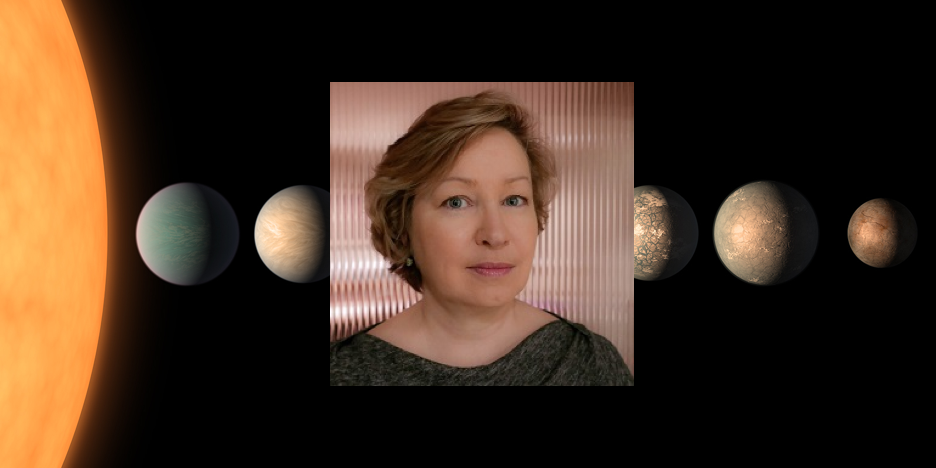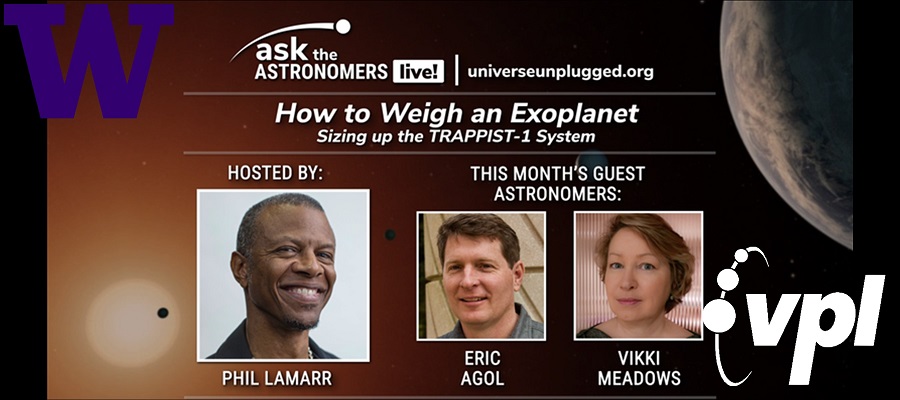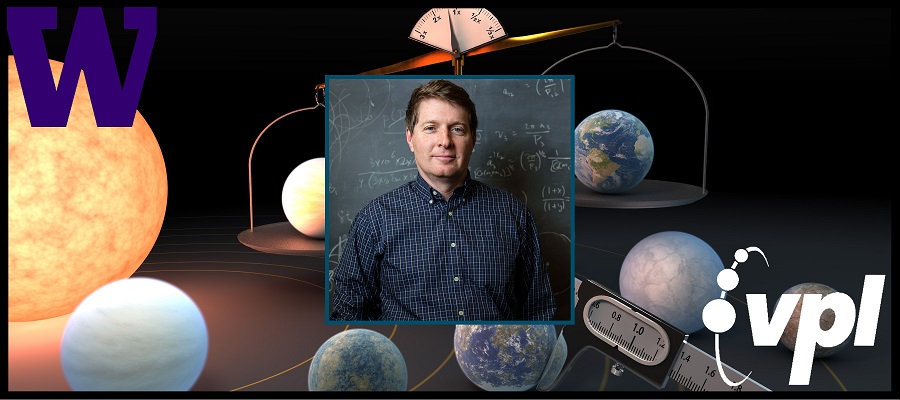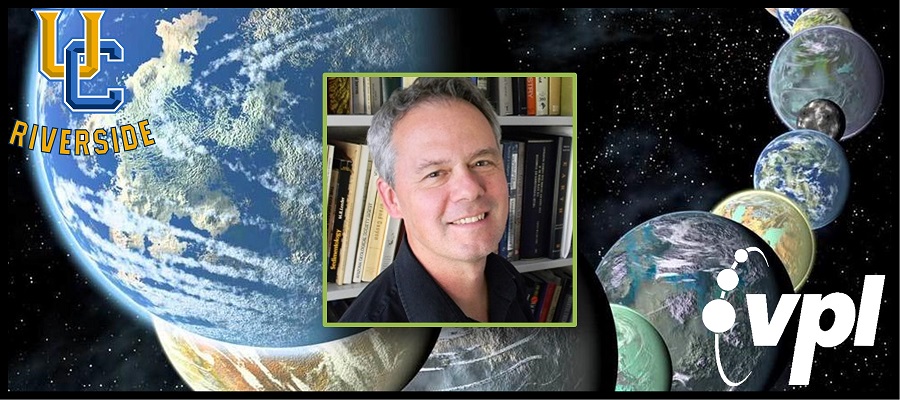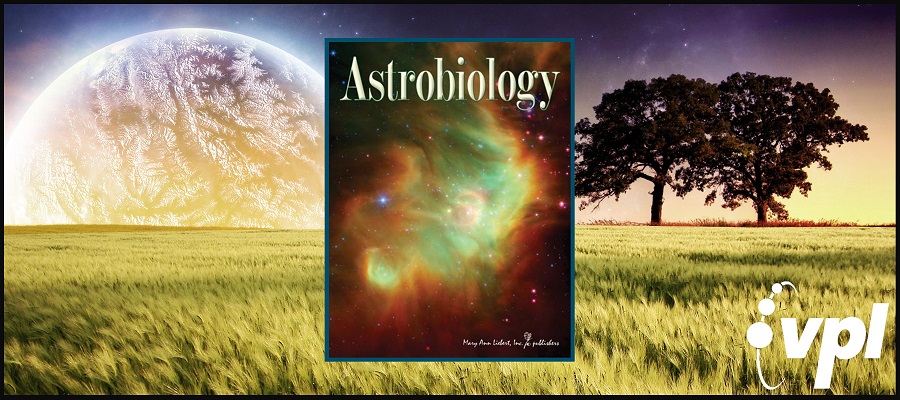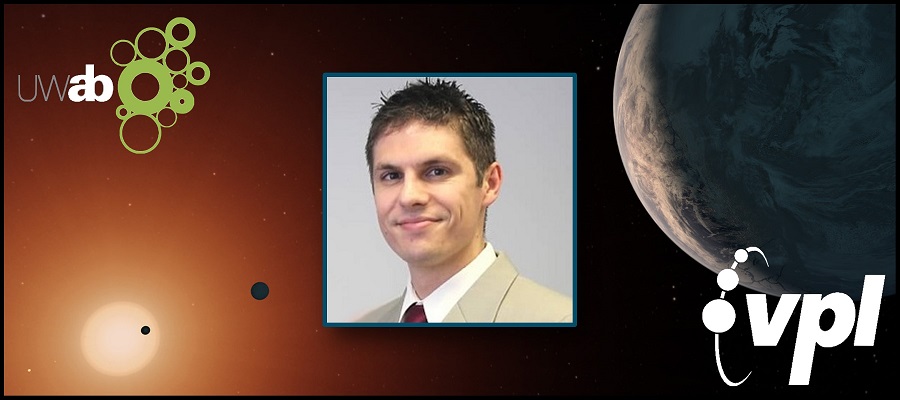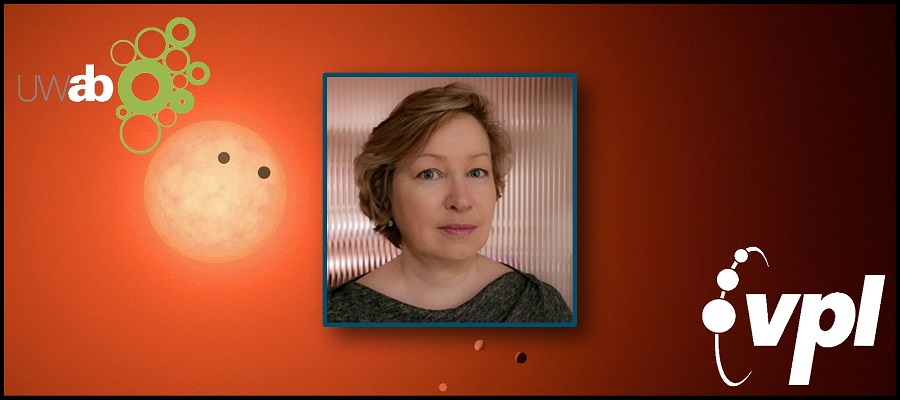Each year, AGU recognizes individuals and teams for their accomplishments in research, education, science communication and outreach. Honorees and their…
The work of VPL PI Prof. Victoria Meadows was recently featured in AAS Nova. Her work, along with VPL researchers…
VPL researchers Eddie Schwieterman and Heather Graham have been featured in an Aeon article on combating the uncertainty associated with…
VPL Postdoctoral Researcher, Andrew Lincowski (University of Washington), and VPL project PI, Victoria Meadows (University of Washington), published two new…
The observation of a 266.94 GHz feature in the Venus spectrum has been attributed to phosphine (PH3) in the Venus clouds, suggesting unexpected geological, chemical, or even biological processes. Since both PH3 and sulfur dioxide (SO2) are spectrally active near 266.94 GHz, the contribution to this line from SO2 must be determined before it can be attributed, in whole or part, to PH3. An undetected SO2 reference line, interpreted as an unexpectedly low SO2 abundance, suggested that the 266.94 GHz feature could be attributed primarily to PH3. However, the low SO2 and the inference that PH3 was in the cloud deck posed an apparent contradiction. Here we use a radiative transfer model to analyze the PH3 discovery, and explore the detectability of different vertical distributions of PH3 and SO2. We find that the 266.94 GHz line does not originate in the clouds, but above 80 km in the Venus mesosphere. This level of line formation is inconsistent with chemical modeling that assumes generation of PH3 in the Venus clouds. Given the extremely short chemical lifetime of PH3 in the Venus mesosphere, an implausibly high source flux would be needed to maintain the observed value of 20 ± 10 ppb. We find that typical Venus SO2 vertical distributions and abundances fit the JCMT 266.94 GHz feature, and the resulting SO2 reference line at 267.54 GHz would have remained undetectable in the ALMA data due to line dilution. We conclude that nominal mesospheric SO2 is a more plausible explanation for the JCMT and ALMA data than PH3.
UWAB faculty member Eric Agol and Program Director Victoria Meadows were recently interviewed by Phil LaMarr with the Universe Unplugged:…
Recently published Atacama Large Millimeter Array (ALMA) observations suggest the presence of 20 ppb PH3 in the upper clouds of Venus. This is an unexpected result, as PH3 does not have a readily apparent source and should be rapidly photochemically destroyed according to our current understanding of Venus atmospheric chemistry. While the reported PH3 spectral line at 266.94 GHz is nearly colocated with an SO2 spectral line, the nondetection of stronger SO2 lines in the wideband ALMA data is used to rule out SO2 as the origin of the feature. We present a reassessment of wideband and narrowband data sets derived from these ALMA observations. The ALMA observations are re-reduced following both the initial and revised calibration procedures discussed by the authors of the original study. We also investigate the phenomenon of apparent spectral line dilution over varying spatial scales resulting from the ALMA antenna configuration. A 266.94 GHz spectral feature is apparent in the narrowband data using the initial calibration procedures, but this same feature cannot be identified following calibration revisions. The feature is also not reproduced in the wideband data. While the SO2 spectral line is not observed at 257.54 GHz in the ALMA wideband data, our dilution simulations suggest that SO2 abundances greater than the previously suggested 10 ppb limit would also not be detected by ALMA. Additional millimeter, submillimeter, and infrared observations of Venus should be undertaken to further investigate the possibility of PH3 in the Venus atmosphere.
VPL Researcher, Eric Agol (University of Washington) is the lead author on a new study of the 7 planets in…
The UCR-based Alternative Earth’s Team has received a five-year funding award from the Interdisciplinary Consortium for Astrobiology Research (ICAR). VPL…
Chirality is considered a universal, agnostic biosignature that is independent of a planet’s biochemistry. Researchers have recently characterized the chiral…
Photosynthesis is an ancient metabolic process that began on early Earth and offers plentiful energy to organisms that can utilize it such that that they achieve global significance. The potential exists for similar processes to operate on habitable exoplanets and result in observable biosignatures. Before the advent of oxygenic photosynthesis, the most primitive phototrophs, anoxygenic phototrophs, dominated surface environments on the planet. Here, we characterize surface polarization biosignatures associated with a diverse sample of anoxygenic phototrophs and cyanobacteria, examining both pure cultures and microbial communities from the natural environment. Polarimetry is a tool that can be used to measure the chiral signature of biomolecules. Chirality is considered a universal, agnostic biosignature that is independent of a planet’s biochemistry, receiving considerable interest as a target biosignature for life-detection missions. In contrast to preliminary indications from earlier work, we show that there is a diversity of distinctive circular polarization signatures, including the magnitude of the polarization, associated with the variety of chiral photosynthetic pigments and pigment complexes of anoxygenic and oxygenic phototrophs. We also show that the apparent death and release of pigments from one of the phototrophs is accompanied by an elevation of the reflectance polarization signal by an order of magnitude, which may be significant for remotely detectable environmental signatures. This work and others suggest that circular polarization signals up to ∼1% may occur, significantly stronger than previously anticipated circular polarization levels. We conclude that global surface polarization biosignatures may arise from anoxygenic and oxygenic phototrophs, which have dominated nearly 80% of the history of our rocky, inhabited planet.
Are we alone in the universe? How did life arise on our planet? How do we search for life beyond…
The development of astrobiology, the study of life in the universe, is intimately tied to the development of spaceflight in the mid to late twentieth century, which enabled the discovery and exploration of non-Earth environments that might harbor life. In 1976, the Viking missions to Mars supported a core goal to search for signs of life beyond Earth (Klein et al., 1972). However, the Viking life detection experiments provided inconclusive evidence of organics and life (e.g., Klein, 1979; Biemann, 1979; Quinn et al., 2013), a result that put a damper on both Mars exploration and exobiology (as astrobiology was known…
Are we alone in the universe? How did life arise on our planet? How do we search for life beyond Earth? These profound questions excite and intrigue broad cross sections of science and society. Answering these questions is the province of the emerging, strongly interdisciplinary field of astrobiology. Life is inextricably tied to the formation, chemistry, and evolution of its host world, and multidisciplinary studies of solar system worlds can provide key insights into processes that govern planetary habitability, informing the search for life in our solar system and beyond. Planetary Astrobiology brings together current knowledge across astronomy, biology, geology, physics, chemistry, and related fields, and considers the synergies between studies of solar systems and exoplanets to identify the path needed to advance the exploration of these profound questions.
Planetary Astrobiology represents the combined efforts of more than seventy-five international experts consolidated into twenty chapters and provides an accessible, interdisciplinary gateway for new students and seasoned researchers who wish to learn more about this expanding field. Readers are brought to the frontiers of knowledge in astrobiology via results from the exploration of our own solar system and exoplanetary systems. The overarching goal of Planetary Astrobiology is to enhance and broaden the development of an interdisciplinary approach across the astrobiology, planetary science, and exoplanet communities, enabling a new era of comparative planetology that encompasses conditions and processes for the emergence, evolution, and detection of life.
Full Citation: Meadows V. S., Arney G. N., Des Marais D. J., and Schmidt B. E. (2020). Preface. In Planetary…
In the near future, extremely large ground-based telescopes may conduct some of the first searches for life beyond the solar system. High spectral resolution observations of reflected light from nearby exoplanetary atmospheres could be used to search for the biosignature oxygen. However, while Earth’s abundant O2 is photosynthetic, early ocean loss may also produce high atmospheric O2 via water vapor photolysis and subsequent hydrogen escape. To explore how to use spectra to discriminate between these two oxygen sources, we generate high-resolution line-by-line synthetic spectra of both a habitable Earth-like and post-ocean-loss Proxima Centauri b.
Robust atmospheric and radiative transfer modeling will be required to properly interpret reflected-light and thermal emission spectra of terrestrial exoplanets. This will help break observational degeneracies between the numerous atmospheric, planetary, and stellar factors that drive planetary climate. Here, we simulate the climates of earthlike worlds around the Sun with increasingly slow rotation periods, from earthlike to fully Sun-synchronous, using the ROCKE-3D general circulation model. We then provide these results as input to the Spectral Planet Model, which employs the Spectral Mapping Atmospheric Radiative Transfer model to simulate the spectra of a planet as it would be observed from a future space-based telescope. We find that the primary observable effects of slowing planetary rotation rate are the altered cloud distributions, altitudes, and opacities that subsequently drive many changes to the spectra by altering the absorption band depths of biologically relevant gas species (e.g., ${{rm{H}}}_{2}{rm{O}}$, ${{rm{O}}}_{2}$, and ${{rm{O}}}_{3}$). We also identify a potentially diagnostic feature of synchronously rotating worlds in mid-infrared ${{rm{H}}}_{2}{rm{O}}$ absorption/emission lines.
VPL graduate student at the University of Washington, Andrew Lincowski, successfully defended his dissertation on Thursday February 27th! Andrew was…
Primary Investigator for the Virtual Planetary Lab research group, Professor Victoria Meadows, gave an invited presentation this past weekend at…
The upcoming launch of the James Webb Space Telescope (JWST) combined with the unique features of the TRAPPIST-1 planetary system should enable the young field of exoplanetology to enter into the realm of temperate Earth-sized worlds. Indeed, the proximity of the system (12pc) and the small size (0.12 Rsun) and luminosity (0.05 Lsun) of its host star should make the comparative atmospheric characterization of its seven transiting planets within reach of an ambitious JWST program. Given the limited lifetime of JWST, the ecliptic location of the star that limits its visibility to 100d per year, the large number of observational time required by this study, and the numerous observational and theoretical challenges awaiting it, its full success will critically depend on a large level of coordination between the involved teams and on the support of a large community. In this context, we present here a community initiative aiming to develop a well-defined sequential structure for the study of the system with JWST and to coordinate on every aspect of its preparation and implementation, both on the observational (e.g. study of the instrumental limitations, data analysis techniques, complementary space-based and ground-based observations) and theoretical levels (e.g. model developments and comparison, retrieval techniques, inferences). Depending on the outcome of the first phase of JWST observations of the planets, this initiative could become the seed of a major JWST Legacy Program devoted to the study of TRAPPIST-1.
We describe a software package called VPLanet that simulates fundamental aspects of planetary system evolution over Gyr timescales, with a focus on investigating habitable worlds. In this initial release, eleven physics modules are included that model internal, atmospheric, rotational, orbital, stellar, and galactic processes. Many of these modules can be coupled to simultaneously simulate the evolution of terrestrial planets, gaseous planets, and stars. The code is validated by reproducing a selection of observations and past results. VPLanet is written in C and designed so that the user can choose the physics modules to apply to an individual object at runtime without recompiling, i.e., a single executable can simulate the diverse phenomena that are relevant to a wide range of planetary and stellar systems. This feature is enabled by matrices and vectors of function pointers that are dynamically allocated and populated based on user input. The speed and modularity of VPLanet enables large parameter sweeps and the versatility to add/remove physical phenomena to assess their importance. VPLanet is publicly available from a repository that contains extensive documentation, numerous examples, Python scripts for plotting and data management, and infrastructure for community input and future development.
Near-term studies of Venus-like atmospheres with James Webb Space Telescope (JWST) promise to advance our knowledge of terrestrial planet evolution. However, the remote study of Venus in the solar system and the ongoing efforts to characterize gaseous exoplanets both suggest that high altitude aerosols can limit observational studies of lower atmospheres, and potentially make it challenging to recognize exoplanets as “Venus-like.” To support practical approaches for exo-Venus characterization with JWST, we use Venus-like atmospheric models with self-consistent cloud formation of the seven TRAPPIST-1 exoplanets to investigate the atmospheric depth that can be probed using both transmission and emission spectroscopy. We find that JWST/Mid-IR Instrument Low Resolution Spectrometer secondary eclipse emission spectroscopy in the 6 ?m opacity window could probe at least an order of magnitude deeper pressures than transmission spectroscopy, potentially allowing access to the subcloud atmosphere for the two hot innermost TRAPPIST-1 planets. In addition, we identify two confounding effects of sulfuric acid aerosols that may carry strong implications for the characterization of terrestrial exoplanets with transmission spectroscopy: (1) there exists an ambiguity between cloud-top and solid surface in producing the observed spectral continuum; and (2) the cloud-forming region drops in altitude with semimajor axis, causing an increase in the observable cloud-top pressure with decreasing stellar insolation. Taken together, these effects could produce a trend of thicker atmospheres observed at lower stellar insolationa convincing false positive for atmospheric escape and an empirical “cosmic shoreline.” However, developing observational and theoretical techniques to identify Venus-like exoplanets and discriminate them from stellar windswept worlds will enable advances in the emerging field of terrestrial comparative planetology.
Habitability is a measure of an environment’s potential to support life, and a habitable exoplanet supports liquid water on its surface. However, a planet’s success in maintaining liquid water on its surface is the end result of a complex set of interactions between planetary, stellar, planetary system and even Galactic characteristics and processes, operating over the planet’s lifetime. In this chapter, we describe how we can now determine which exoplanets are most likely to be terrestrial, and the research needed to help define the habitable zone under different assumptions and planetary conditions. We then move beyond the habitable zone concept to explore a new framework that looks at far more characteristics and processes, and provide a comprehensive survey of their impacts on a planet’s ability to acquire and maintain habitability over time. We are now entering an exciting era of terrestiral exoplanet atmospheric characterization, where initial observations to characterize planetary composition and constrain atmospheres is already underway, with more powerful observing capabilities planned for the near and far future. Understanding the processes that affect the habitability of a planet will guide us in discovering habitable, and potentially inhabited, planets.
The James Webb Space Telescope (JWST) will offer the first opportunity to characterize terrestrial exoplanets with sufficient precision to identify high mean molecular weight atmospheres, and TRAPPIST-1’s seven known transiting Earth-sized planets are particularly favorable targets. To assist community preparations for JWST observations, we use simulations of plausible post-ocean-loss and habitable environments for the TRAPPIST-1 exoplanets, and test simulations of all bright object time-series spectroscopy modes and all Mid-Infrared Instrument photometry filters to determine optimal observing strategies for atmospheric detection and characterization using both transmission and emission observations. We find that transmission spectroscopy with the Near-Infrared Spectrograph Prism is optimal for detecting terrestrial, CO2-containing atmospheres, potentially in fewer than 10 transits for all seven TRAPPIST-1 planets, if they lack high-altitude aerosols. If the TRAPPIST-1 planets possess Venus-like H2SO4 aerosols, up to 12 times more transits may be required to detect an atmosphere. We present optimal instruments and observing modes for the detection of individual molecular species in a given terrestrial atmosphere and an observational strategy for discriminating between evolutionary states. We find that water may be prohibitively difficult to detect in both Venus-like and habitable atmospheres, due to its presence lower in the atmosphere where transmission spectra are less sensitive. Although the presence of biogenic O2 and O3 will be extremely challenging to detect, abiotically produced oxygen from past ocean loss may be detectable for all seven TRAPPIST-1 planets via O2O2 collisionally induced absorption at 1.06 and 1.27 ?m, or via NIR O3 features for the outer three planets. Our results constitute a suite of hypotheses on the nature and detectability of highly evolved terrestrial exoplanet atmospheres that may be tested with JWST.
Terrestrial planets orbiting M dwarfs may soon be observed with the James Webb Space Telescope (JWST) to characterize their atmospheric composition and search for signs of habitability or life. These planets may undergo significant atmospheric and ocean loss due to the superluminous pre-main-sequence phase of their host stars, which may leave behind abiotically generated oxygen, a false positive for the detection of life. Determining if ocean loss has occurred will help assess potential habitability and whether or not any O2 detected is biogenic. In the solar system, differences in isotopic abundances have been used to infer the history of ocean loss and atmospheric escape (e.g., Venus, Mars). We find that isotopologue measurements using transit transmission spectra of terrestrial planets around late-type M dwarfs like TRAPPIST-1 may be possible with JWST, if the escape mechanisms and resulting isotopic fractionation were similar to Venus. We present analyses of post-ocean-loss O2- and CO2-dominated atmospheres containing a range of trace gas abundances. Isotopologue bands are likely detectable throughout the near-infrared (18 ?m), especially 34 ?m, although not in CO2-dominated atmospheres. For Venus-like D/H ratios 100 times that of Earth, TRAPPIST-1b transit signals of up to 79 ppm are possible by observing HDO. Similarly, 18O/16O ratios 100 times that of Earth produce signals at up to 94 ppm. Detection at signal-to-noise ratio = 5 may be attained on these bands with as few as four to 11 transits, with optimal use of JWST’s NIRSpec Prism. Consequently, H2O and CO2 isotopologues could be considered as indicators of past ocean loss and atmospheric escape for JWST observations of terrestrial planets around M dwarfs.

